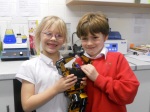Dad’s Robot Lab!
Last week, we had some visitors! They demonstrated how all of the robots worked. There were some amazing remote controlled robots and a Lego robot. The name of the person who worked with all of the extraordinary robots was Scott Turner. We were amazed by the robots. Thank you for coming.
 The Lego robot could be controlled by the computer. The other robot could do handstands, roly-polys and cartwheels. Some were doing gymnastics, walking, bowing and dancing. The Lego robot just went all over the place!
The Lego robot could be controlled by the computer. The other robot could do handstands, roly-polys and cartwheels. Some were doing gymnastics, walking, bowing and dancing. The Lego robot just went all over the place!
Emily’s stepdad, Robin, said “It was fantastic – I want a robot for Christmas.”Unfortunately they are £800! And Kris, Kieran’s dad said “Thanks for organising the robot lab … a nice little event, an amazing robot!”

The robots used can be found at the Active Robots site : http://www.active-robots.com/robots/robot-kits-1/robonova-humanoid-robot-rtw-ready-assembled.html
If you would like to know more about the Junkbots project contact scott.turner@northampton.ac.uk

























